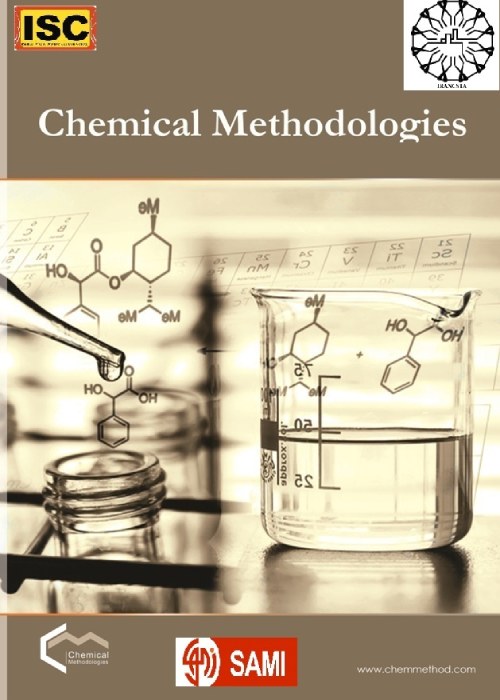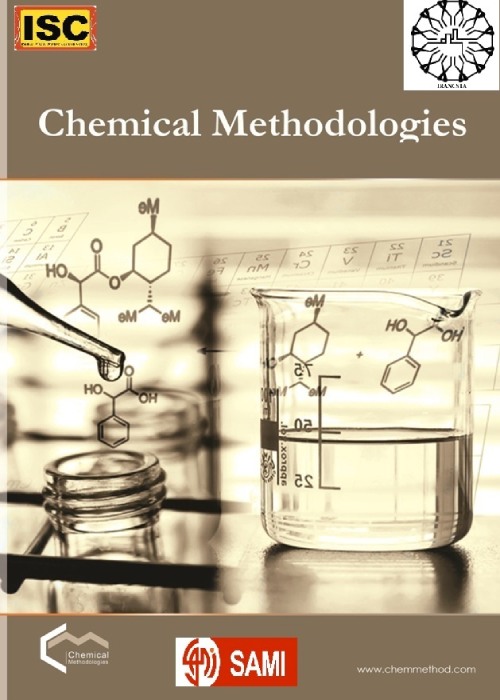فهرست مطالب

Chemical Methodologies
Volume:7 Issue: 12, Dec 2023
- تاریخ انتشار: 1402/09/10
- تعداد عناوین: 5
-
-
Pages 904-915Nitric oxide synthase (NOS) preferentially produces its inducible isoform (iNOS) in several cells, including macrophages, which are in charge of the immunological response. It is widely known that the expression of iNOS and the consequent production of nitric oxide (NO) have various biological benefits, such as anti-inflammatory and antioxidant properties. However, the overexpression or dysregulation of iNOS can result in the excessive release of NO, which may contribute to the pathogenesis of several disorders. Examining how bioactive plant components interact with iNOS may yield comprehensive and conclusive details on the processes of inhibition. The objective of this study was to employ molecular docking techniques for the investigation of molecular interactions between the iNOS enzyme and specific bioactive compounds, namely resveratrol, 6-gingerol, quercetin, and hydroxytyrosol. The Protein Data Bank (PDB) was the source of the crystal structure for the target protein, iNOS. In contrast, the three-dimensional (3D) structures of the bioactive compounds were acquired from the PubChem database. AutoDock Vina was employed for docking simulations of iNOS inhibitor compounds. The findings from the molecular docking analysis indicated that each of the chosen bioactive substances demonstrated inhibitory effects on iNOS. Furthermore, these compounds consistently formed interactions with the primary protease at the same binding site across all docking studies. The obtained results suggest that quercetin, among other phenolic compounds, could be a potential alternative for iNOS inhibition in a therapeutic context. Nevertheless, computer simulations represent the initial stage in the development of inhibitory compounds, and further research and clinical applications are essential.Keywords: phenolics, iNOS inhibition, Molecular docking, Inflammation, Computational Biology
-
Pages 916-943Gas treatment procedures play a crucial role in eliminating acidic gases from natural gas and other hydrocarbon streams. Within the confines of this investigation, we propose an innovative methodology that employs the eCPA equation of state to prognosticate the solubility of hydrogen sulfide (H2S) in aqueous solutions containing N-methyl diethanolamine (MDEA), monoethanolamine (MEA), and diethanolamine (DEA). The electrolyte Cubic Plus Association (eCPA) equation of state takes into account six vital parameters, encompassing the molecular size, configuration, and polarity of the constituents, to accurately anticipate the equilibrium treatment of H2S absorption in various conditions.The results acquired from the experimental assessment of H2S solubility were juxtaposed with those derived from modeling, revealing a commendable concordance amidst the respective data. In order to gauge the accuracy of the projected model, we employed the absolute average relative deviation (AARD%) as a statistical error-index. The experimental data procured in this study exhibited an acceptable validation in accordance with the outcomes of modeling endeavors.The performance evaluation reveals that, within the temperature range of 25-140 °C, acid gas loadings of 0-1.6 (mol gas/mol solution), and aqueous alkanolamine amounts of 15-49 wt. %, the absolute average relative deviation (AARD%) remains consistently below 4.5%. This emphasizes the reliability and efficiency of our model in accurately predicting H2S solubility under diverse operating conditions.Keywords: H2S, DEA, MDEA, MEA, Solubility, eCPA EoS
-
Pages 944-963An eight-membered spiro-alkoxy compound Tris[N-(2-(λ1-oxidanyl(ethyl)-2-(λ2-azanyl) ethan-1-amine] N3P3(OC2H5NC2H5N)3 was synthesized by replacing the chlorine atoms of Hexachlorocyclotriphosphazene (HCCTP) with 2-[(2-aminoethyl)amino]ethanol (AEAE) groups. The structure of Tris[N-(2-(λ1-oxidanyl(ethyl)-2-(λ2-azanyl) ethan-1-amine] (TAEAEAP), was characterized through the utilization of several spectroscopic techniques, such as IR, 1H-NMR, 13C-NMR, 31P-NMR, UV, and fluorescence spectroscopy. In addition, we performed DFT level for predicting vibrational spectra, to obtain structural parameters, including the conformation of the substitutional rings, bond lengths, and bond angles. The theoretical and experimental vibrational spectra were compared to validate the proposed model. Moreover, we investigated the emission spectra of TAEAEAP in the presence and absence of metal cations, such as Pb2+, Cu2+, Ni2+, and Cd2+, in a safe and non-toxic solvent mixture of H2O/MeOH (9:1, v/v). The biocompatibility of TAEAEAP was evaluated through an MTT assay conducted on healthy L929 fibroblast cells. Furthermore, molecular docking studies of TAEAEAP with tumour suppressor (1BD8) and transferase/transferase inhibitor (3NUP) proteins were performed. This study involved an investigation into the synthesis, structural analysis, and antibacterial properties of a purple-coloured complex, bis[tris(2-ethylaminoethyl)amine]copper(II) dinitrate, that was formed from the reaction between copper nitrate and TAEAEAP.Keywords: antibacterial, MTT assay, DFT, Chemosensor, Spirocyclic phosphazene, Molecular docking
-
Pages 964-993
One of the most significant medication families of drugs utilized for intensive treatment, and acute or chronic pain are morphine, opium, and opium-like drugs. The chemical synapse is the place of the effect of drugs and neurotransmitters. Opioids exert their analgesic properties through biochemical changes at chemical synapses by stimulating opioid receptors. Opioids prevent the transmission of pain messages to higher nerve centers by releasing the inhibitory transmitters in the synapse. The problem of using these substances is addiction and severe dependence on them due to the feeling of euphoria, relaxation, and painlessness caused by the use of these substances. Many aspects of the clinical action of opiates are still unknown. Therefore, research on the novel features of these compounds is ongoing in biochemistry and pharmaceutical sciences to synthesize drugs with fewer side effects and more effectiveness. On the other hand, the gate theory is one of the most important theories in controlling pain signals and analgesic drugs. Therefore, comprehensive knowledge and study of analgesic compounds are necessary to achieve the primary goal. Aromatic NH such as in tetrazole and mitragynine, and NH resonance next to the carbonyl functional group like that in carbamates has a high potential to create opioid properties due to the potential of creating tautomeric structures.
Keywords: Chemical Synapses, Pain Chemistry, Gate Theory, Agonist-Antagonist Drugs, tetrazole, Carbamate -
Pages 994-1010The spray pyrolysis technique is a versatile and cost-effective method for producing TiO2-NiO@In2O3 NCTFs on glass substrates with varying molar ratios. NCTFs have been studied for gas-sensing applications due to their excellent sensing properties. The films' structural, morphological, and gas-sensing characteristics were analyzed. The XRD analysis indicates that the NCTFs are polycrystalline, meaning that they are made up of many small crystals. The crystals are oriented in a random fashion, which is why the XRD pattern is broad. The anatase phase of TiO2 is a tetragonal crystal structure. The NiO and In2O3 phases are both cubic crystal structures. The presence of nanostructure cubic phases indicates that the nanoparticles in the films are small enough to significantly affect the crystal structure of the films. Scanning electron microscopy images showed surface homogeneity, with small granular grains of nanostructures without any cracks. The gas sensor created using the prepared samples showed high sensitivity to NO2 and H2S gases, and its sensitivity was measured at different operation temperatures, along with response and recovery times. The optical properties of In2O3 are affected by the addition of TiO2 and NiO impurities. The In2O3 transmittance increases as the NiO ratio increases and the TiO2 ratio decreases.Keywords: TiO2-NiO@In2O3 NCTFs, glass substrate, crystal structure, High sensitivity, NO2, H2S gas sensors, Optical properties


